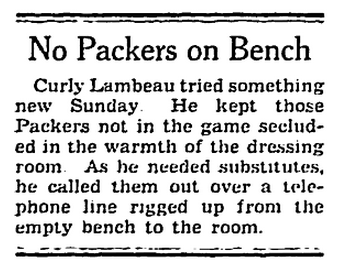The game time forecast for Foxborough on Saturday is a balmy 17 degrees with a 7 mph wind. In Green Bay the next day, we’re looking at snow, 5 degrees and an 18 mph wind. But the games will go on, of course, because the games always go on, barring a natural disaster or some national tragedy. If football is a test of manhood, then football in January — in the northern climes, at least — is the ultimate Final Jeopardy.
While the Patriots, Ravens, Packers and Cowboys are busy stocking up on thermal wear, let me tell you about the time an NFL coach dealt with frigid weather in a most unusual way: by keeping his subs in the heated locker room instead of having them freeze their butts off on the sideline.
Actually, it wasn’t just any old NFL coach. It was Green Bay Hall of Famer Curly Lambeau. That’s right, the franchise that gave us the Ice Bowl also gave us — what should we call this, the Empty Bench Play?
The date was Dec. 6, 1942, a day shy of the first anniversary of Pearl Harbor. The site was State Fair Park in Milwaukee, where the Packers played some of their home games in those days. Jack Sell of the Pittsburgh Post-Gazette described the setting thusly:
“Only 5,183 fans braved sub-freezing temperatures to witness what was probably the final league game of pro football for the duration. Snow was swept from the grid in midweek but was piled high near the sidelines and often ball carriers were tossed into it. Most of the players wore basketball shoes.”
At kickoff, the temperature was around 10 degrees, and Lambeau, always looking for an edge, decided if his players weren’t on the field, moving around, they were better off indoors. So he stationed backfield coach Eddie Kotal in the dressing room and communicated with him by  phone. Whenever Curly needed a replacement he’d call Kotal, and Eddie would send one running out — with feeling in all four of his extremities. That was better that you could say for the Steelers reserves, who huddled under blankets to try to keep warm.
phone. Whenever Curly needed a replacement he’d call Kotal, and Eddie would send one running out — with feeling in all four of his extremities. That was better that you could say for the Steelers reserves, who huddled under blankets to try to keep warm.
“The move occasioned a lot of surprise on the part of the fans, who couldn’t figure out, at the start of the game, where the substitutes were,” Don Hickok of the Green Bay Press-Gazette reported. You have to understand, though: The Packers had never played a home game in December before — and wouldn’t play another for almost a decade. Back then, they scheduled their Green Bay/Milwaukee games for the first part of the season, when the weather was more conducive to drawing a decent crowd, and spent the latter part of the season on the road. In 1929, the year they won their first title, they played their first five at home and their last eight away.
Toward the end of the game, won by the Packers, 24-21, Hickok left the press box and went down to the Green Bay locker room to survey the scene. His account:
Kotal sat on a table with his ear against the telephone . . ., his other ear cocked toward the radio [and the play-by-play of WTMJ’s Russ Winnie]. The players were silent except when one of them missed [the] description of the play and asked what it was.
[Quarterback] Cecil Isbell came in with about three minutes to play and lifted his pant-legs to display two badly skinned knees, the result of his smashing [tackle] of [Pittsburgh’s] Bill Dudley after a pass interception down on the Packer[s] 20-yard line, which saved a touchdown. . . . The effort cost the Packer[s] pitcher several square inches of skin when he skidded along the frozen ground on his knees. So far as the effect on the players was concerned, the field might as well have been paved.
There was some concern, as Sell mentioned, that the NFL might shut down after the season because of a manpower shortage. So many able-bodied men were already in the military, and more were on the way. And, indeed, the league had to get creative to keep going in 1943. The Rams, after all, ceased operations that year and dispersed their players — on a lend-lease basis — to other clubs. The Steelers and Eagles, meanwhile, merged, creating a two-headed “Steagles” monster that finished a game out of first place in the East.
As for Curly Lambeau, he went right on thinking. In October of ’43 he coached a game against the Lions not from the sideline but from the press box — just to satisfy his curiosity. “You can see so much more here,” he said afterward. “I’m going to do it again.”
So it was in the 1940s, when pro football was being invented. Coaches would try just about anything.

